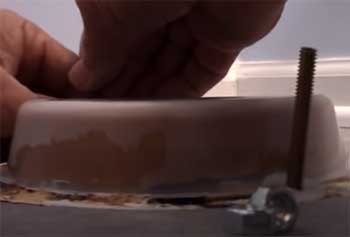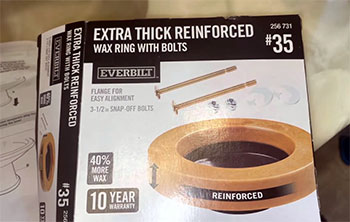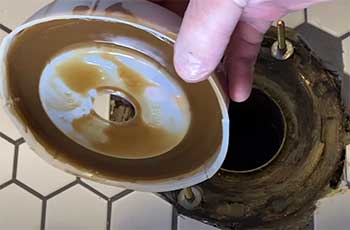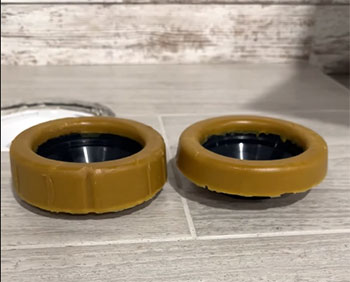While installing your toilet, you have to consider plenty of things for a proper installation. One of the most confusing and technical things is the wax ring size.
It can be tricky to determine that factor without having adequate knowledge of it.
Keeping up with that, I will be going through an overview of extra thick wax rings vs. regular wax rings. So, by the end of this article, you will learn when to use which size for the best results.
Let’s get going.
A Quick Comparison Between The Wax Rings
Well, since both the items are wax rings, you will hardly find any differences between them. Still, if I were to summarize the differences, it would be something like this –
| Wax type | Regular | Extra thick |
| Thickness | 3/4inch to 1inch | 2 inches |
| Weight | Light | Heavy |
| Price | Less expensive | Expensive |
| Installation | Easier | Complicated |
Going through this table truly doesn’t tell you much about the wax rings. Most importantly, you still don’t know which one to use in your case, right?
So, let’s dive a little deep and check out the other factors with both these wax ring types to see which one you should get.
Primary Differences Between The Two Wax Ring Types

Since both are wax rings, there are no basic differences in their functionality or composition. Some things that differ between these two are the thickness and application.
So, let’s check out how they differ and their impact on applying these rings.
- Thickness
When it’s about a regular wax ring, it will come with a thickness of around 3/4inch to 1-inch. It’s the most common wax ring size and is used much more commonly. Also, it’s the lowest thickness available for wax rings.
On the other hand, an extra thick wax ring or double thick wax ring has a thickness of at least 2-inches. As you can pretty much tell, it’s double than the regular ones.
So, it will be much thicker and heavier than the regular one, given that they are made of the same material.
- Application Variation
Now, the real thing to know is the application of the two wax rings. Surprisingly, this doesn’t depend on the wax rings themselves.

Which one you will use and apply in your case depends on your toilet. Depending on the toilet flange, you will have to decide on one option.
You can find the toilet flange around the floor pipe underneath the toilet. You have to check the depth of the flange to decide which wax ring you will be using.
If the toilet flange is level with the floor or within the range of 1/4inch of it, then you will need to use a regular wax ring.
If you find the flange recessed deeply in the floor, you must use a double-thick wax ring for the toilet. A common instance for this is if you have installed a new thicker flooring than the existing flooring.
You will need to use a double-thick wax ring in that scenario, even if you might have used a regular one earlier.
- Weight
There is a clear difference in weight between the two types of wax rings. Typically, the extra thick wax ring will be much heavier than a regular wax ring.
The reason for that is the extra material in the ring.
However, this doesn’t impact the results of the toilet seal. It just makes sure you can cover the more significant portion with the extra material.
The weight has nothing to do with the results of the wax ring.
- Price
An obvious difference between these two options is in their pricing. I mean, the extra thick wax ring would be a bit more expensive than the regular wax ring.
Since they are made of the same material but differ in size, the price will also differ based on the size.
Well, these are the basic differences between the wax rings. There aren’t many differences in their functionality.
You can’t truly choose an option based on their features. You will always need to decide based on your toilet flange anyways.
Pros of Standard Wax Rings
Cost
Standard wax rings range from $3-$10, making them the clear budget choice. Extra thick rings cost 2-3 times as much in most cases.
Availability
Regular wax rings can be found at any hardware store and many big box retailers. Specialty extra thick rings may require a trip to a major plumbing supply outlet.
Ease of Installation
Standard rings easily slide into place under the toilet base with finger pressure. Extra thick versions take more effort to fully seat correctly.
Adequate for Most Installs
Regular 1/4″ rings work sufficiently well for sealing the majority of toilet installations, as long as floor level and flange height are properly matched.
Industry Standard
Contractors are accustomed to working with regular wax rings. The typical installation process matches standard ring dimensions.
Cons of Standard Rings
Potential Leaks on Uneven Surfaces
If the floor has any slant or gap exceeding 1/4 inch under the toilet base, a standard ring may not fully seal the space and lead to leaks.
Lacks Reinforcement
Without an integrated firm ring or other reinforcement inside the wax, standard seals can be prone to warping or shifting after prolonged use.
Insufficient Wax Volume
With only around 3 ounces of wax, regular rings may not provide enough sealing material for larger gaps or porous flooring.
Thin Seal
On raised flanges or uneven surfaces, the minimal 1/4 inch thickness of basic wax rings can result in an incomplete seal and rocking toilet.
Frequent Replacement Needed
The soft wax of basic rings wears out after 5-10 years, requiring replacement during renovations or upon any leaks.
Pros of Extra Thick Wax Rings

Prevent Leaks on Imperfect Surfaces
The extra depth and width of wax compensates for floors not perfectly level under the toilet, forming a complete seal.
Stability with More Wax
The larger volume of wax, around 6 ounces, makes a more stable, durable seal less prone to shifting or leaks.
Conforms to Wide Gaps
Thicker rings can mold into gaps up to around 3/4 inch below the flange to prevent seepage into subfloor.
Stiffer Support
Many extra thick rings include a firm inner sleeve or support structure to prevent rocking and warping over years of use.
Long Lasting
Reinforced extra thick rings maintain integrity for 10-20 years in most cases, avoiding frequent replacements.
Cons of Extra Thick Rings
Expense
Costing from $10-$20, extra thick specialty wax rings can be over 3 times more expensive than basic versions.
Limited Availability
Finding reinforced rings often requires going to a specialty plumbing supply store rather than standard retail locations.
Difficult Installation
Installing thick rings takes more work to fully seat them under the toilet base when maneuvering into place.
Potential Wax Deformation
If not installed correctly, the soft wax in extra thick rings can warp, smear, or become misaligned under toilet weight.
Might Not Be Necessary
On flat, stable surfaces with proper flange height, the extra thickness is extraneous. A standard ring seals sufficiently.
Who Wins The Competition?
If I had to choose a winner between the two wax rings, it would be much more difficult because both the products have their use in particular scenarios.
For example, if you have a toilet on floor level, you will need to use the regular wax rings.
As for the deeply recessed toilet, you will have to opt for an extra thick one. Using the regular in that scenario will not yield proper results at all.
Can Choosing The Wrong Size Cause Any Issues?

Yes, if you choose the wrong thickness of the ring size, there can be several issues that you will face with your toilet.
One of the major issues that you will face is the toilet leaking due to the wrong wax size.
When you use a regular wax ring in place of a double-thick wax ring, you will have this issue of leaking. When you use a regular wax ring, it leaves some space from where the toilet starts leaking.
On the other hand, if you try to use a double-thick wax ring in place of a regular one, you won’t be able to fit it in the first place.
So, there is no point in getting a double-thick wax ring where you should be using regular wax rings.
How To Know If The Wax Ring Is Working Or Not?
It’s very easy to notice whether your toilet seal is working correctly or not. Because the seal isn’t working, you will come across several issues.
The first thing to notice is water seeping through the toilet base.
This is a clear sign that your wax ring is not working properly. Even if you don’t notice the water seeping through, you will notice the stains that they leave on the toilet base.
So, make sure to keep an eye out for that.
Is A Wax Ring The Best Option For A Toilet Seal?
Well, this is a debatable topic to discuss. For a wax ring, the alternative you get is typically a rubber gasket seal. Now, there are plenty of advantages to the rubber gasket seal that you don’t get in a wax ring.

At the same time, wax rings also have their benefits.
It all comes down to your preferences regarding the seals. If you want something that doesn’t cause any mess and is very easy to replace, then a rubber gasket seal works out the best.
But if you want your toilet seal to last for a long time, then wax rings are better options to go with.
Even if the installation of wax rings can be a bit difficult and messy, they are well suited when it’s about longevity.
Key Considerations Comparing Wax Ring Types
- Check floor levelness under installation area before deciding between standard and thick rings.
- Consider flange height carefully relative to the toilet base to ensure correct wax thickness.
- Remove all old wax, bolts, and debris under existing toilets to allow proper seating of new ring.
- Extra thick rings often have size options to match different flange heights and toilet types.
- The added cost of reinforced rings can avoid much greater expense from leaks causing subfloor damage.
- Take care installing extra thick rings to keep the wax soft and pliable as needed for maximum sealing.
- Combining thick wax rings with rubber gaskets provides added insurance against leaks on uneven surfaces.
- Test toilet stability and re-set if any rocking occurs after installing thicker wax seals.
Frequently Asked Questions (FAQ)
Here are some questions that a lot of people ask regarding the different wax ring types –
You will need to use an extra-thick wax ring whenever you are dealing with a flange that is on the floor level or maybe a bit below or deeper to the floor level. Anything below ¼” should clearly indicate using an extra thick wax ring.
Sometimes the wax rings you will need for sealing your toilet will be extra thick because of the extra space they have to cover. Without the extra thick layer of the wax rings, you can’t cover up the larger toilet flanges properly. This may even result in your toilet leaking at some point. That’s some wax rings extra thick.
To find out the size of the wax ring that you should be using, you will need to check up on your toilet bowl. Turn it upside down and see the opening on the lower part of your toilet. Based on that, you will need to determine the wax ring size.
Yes, you can use two regular wax rings instead of using one extra thick wax ring. However, that won’t be the most efficient way to seal your toilet because there will still be a chance of leakage around it. If your toilet requires a double-thick wax ring, I recommend going for that instead of using two regular wax rings.
Waxless or rubber toilet rings are typically very good for the reusability factor. They are also great when it comes to clean-up and installation. You don’t have to go through much trouble cleaning these toilet seals. Also, it’s easier to handle compared to wax rings. So, altogether, they are pretty good in their purpose.
A jumbo or extra thick wax ring contains around double the amount of wax compared to a standard ring, making it about 3/8″ thick or more. The key reasons to use a jumbo wax ring are to seal larger gaps between the toilet base and floor, provide more stability on uneven surfaces, and create a durable long-lasting seal. They are ideal for replacing leaky toilets, raised flanges, and tile floors with slight gaps or slants. The extra wax fills more space and conforms better.
Conclusion
All in all, choosing a toilet seal between extra thick wax rings vs. a regular wax ring is all about the placement of your toilet flange.
If it’s deeper into the floor, then you will need an extra thick wax ring. But if it’s at a normal height or on the floor level, then you can use the regular ones.
In terms of performance or effectivity, there isn’t much difference between the two. But make sure to consider the proper thickness.
Otherwise, you will face crucial issues. And replacing a toilet seal can be very difficult.

